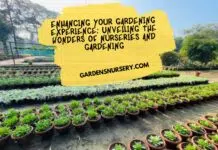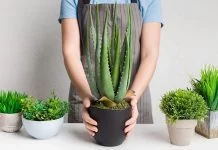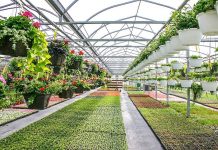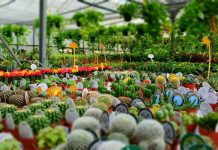Best 10 Mistakes to Avoid at the Nursery

It’s time to turn off the TV, throw open your doors, and get outside; your garden awaits! But after you’ve raked up last fall’s leaves and taken a good hard look at your garden’s blank palette, your next step is to visit your local garden nursery.
There, you’ll be treated to the sights and smells of spring. But before you take out your wallet, take a quick read of our 10 important points to keep in mind before you shop. And enjoy!
Mistake 1: Buying Flowers in Bloom

Think twice before buying open flowers. There is no rule that says you have to buy the plant with open blooms.
In fact, we suggest you buy your fall-blooming plants in the spring and the spring bloomers in the fall, giving your plants a chance to have more time to get established.
The exception is for annuals, which only bloom for one year! Even still, it’s better to pick an annual with lots of buds and no open flowers—that way you’ll have more bang for your buck when the annuals are planted. (After all, where do you want your plants to flower? In the nursery or in your garden?)
Mistake 2: Not Checking Plant for Spots
Is it fertilizer or is it mildew? Be careful when you’re buying and look closely at the leaves for signs of disease or mildew.
But don’t be confused by fertilizer residue that often remains on leaves at nurseries—if you’re not sure, ask. Also make sure to check for unusual spots, discoloration, or insects.
Make sure that the plant has lots of perky leaves and signs of new growth or there could be trouble.
Mistake 3: Mistaking Size for Value
Bigger doesn’t always mean better. Bigger plants often cost bigger dollars. But beware: you’re not necessarily getting a larger plant.
To double-check, put your fingers about an inch or so into the pot. If you feel mostly soil (as opposed to roots), then chances are that your plant has been repotted into a bigger container. And even if the plant is actually a bigger plant, there are few benefits to spending more money on a one-gallon plant than a four-inch pot.
If you have the patience to wait a few seasons for your plants to grow, you can save considerable money by purchasing smaller pots.
Mistake 4: Being too Frugal
It happens time and again. Gardeners buy insufficient amounts of a single variety of a certain plant. The result is a garden with not enough impact.
Assess your garden before you shop and decide if it makes more sense to buy three or four pots of the same annual or perennial. Professional gardeners often plant a mass of one specific variety—the impact is worth the investment.
Mistake 5: Skimping on Trees
If you’re buying trees or shrubs, being frugal may REALLY not be the right decision. Unlike perennials, trees, and shrubs generally take longer to develop a sturdy and attractive structure.
Budget appropriately—if you want an ornamental tree in your yard, for example, be realistic about how much it will cost.
Think of the purchase as an investment—all good garden design needs a focal point.
Mistake 6: Not Checking the Roots
Explore your roots. Make sure your plant doesn’t root-bound. All you need is a quick check of the bottom of the plant to make sure that there isn’t a mass of roots coming out of the holes in the bottom of the container.
A tangle of too many roots can rob the plant of nutrients. Similarly, make sure that the plant has some roots—if you’re not sure if the plant is mature enough to take home, ask your nursery specialist.
Mistake 7: Forgetting your Shopping List
Like any kind of shopping, if you don’t bring your list, you may end up with too many impulse purchases.
Even if you’re not sure exactly what cultivars you want, try to go to the nursery with a realistic idea of the dimension of your garden as well as the climate and soil conditions of your garden.
Mistake 8: Buying a Plant Without an Identifying Tag
Designer or no-name? As with many products, there are generic versions of plants as well as patented commercial varieties. Generally speaking, a designer cultivar is often more expensive.
Whether the extra expense is worth it is entirely subjective, but one thing is for sure: make sure your plant DOES have an identifying tag on it (designer OR generic) before you buy it.
If the plant is unlabelled, avoid buying it (even if you think you recognize it)—you may end up with something that grows four feet tall when you were only expecting it to grow to two feet!
Mistake 9: Throwing Away Your Receipts
Keep your receipts. A lot of nurseries offer one-year warranties for their plants.
It is definitely worth it to keep all of your receipts in order to return the plant if it develops issues and doesn’t survive.
But be fair to the nursery: if you don’t water or care for your plants properly, don’t expect the nursery to pay for your mistakes.
Mistake 10: Procrastination
How many times have you gone to the garden center, bought a few flats of plants, and then brought them home, planning on planting them later? And then you don’t get around to it right away. If you wait too long to put the pots in the ground, the plants may dry out and die.
Try to shop early in the morning so that you can plant your purchases as soon as you get home. To figure out where they should go, you can position them around your garden while they’re still in their pots before you plant them.
Don’t make any plant purchases without having these savvy gardening tips close at hand.
additional tips to help you avoid mistakes at the nursery
Here are some additional tips to help you avoid mistakes at the nursery:
- Not researching the plants you’re buying: Before you buy a plant, do some research on its care requirements and make sure it’s a good fit for your lifestyle and environment.
- Buying plants that are in poor condition: If a plant looks unhealthy or stressed at the nursery, it’s likely to continue to struggle once you bring it home. Instead, choose plants that look healthy and vigorous.
- Ignoring the plant’s mature size: Many plants grow much larger than their initial size. Be sure to consider the mature size of the plant before buying it and make sure you have enough space for it to grow.
- Not acclimatizing the plant: If you’re moving a plant from a nursery to your home or garden, it’s important to acclimate it gradually to its new environment. This can help prevent shock and stress to the plant.
- Using the wrong type of soil: Different plants have different soil requirements. Make sure you use the right type of soil for the plants you’re buying.
- Not providing adequate drainage: Proper drainage is essential for plant health. Make sure the pots you choose have drainage holes and that the soil can drain freely.
By following these tips, you can avoid common mistakes and set your plants up for success. Remember, plants are living things that require care and attention, but with the right approach, they can bring beauty and joy to your life.









